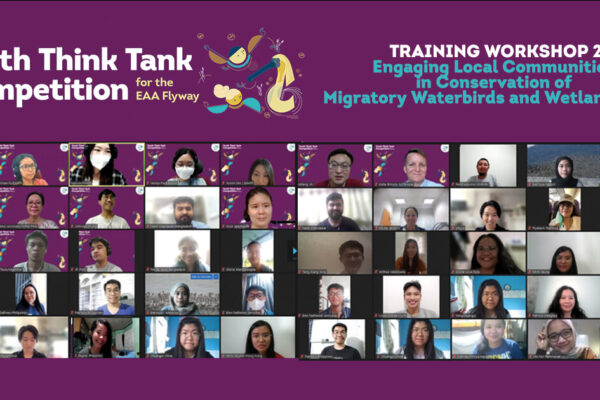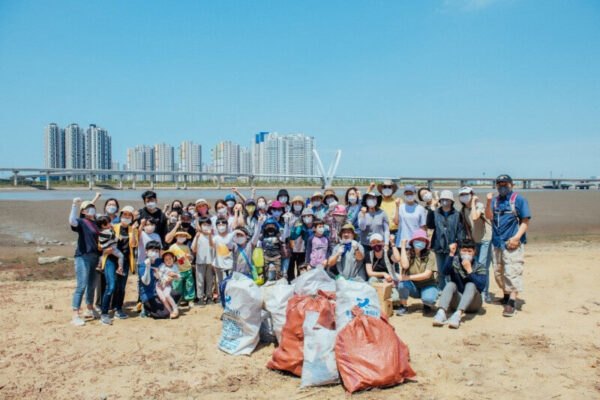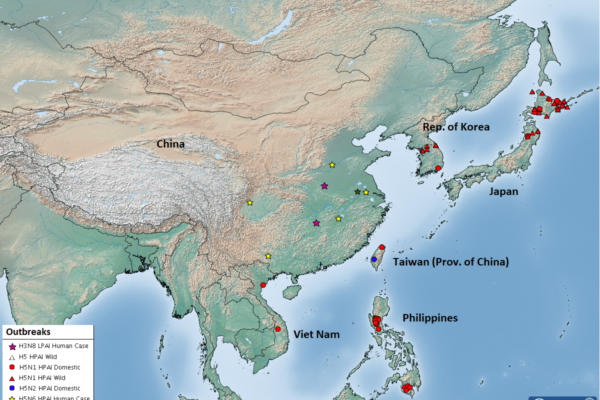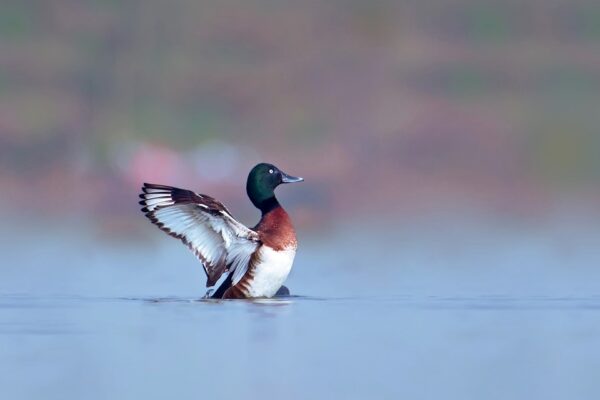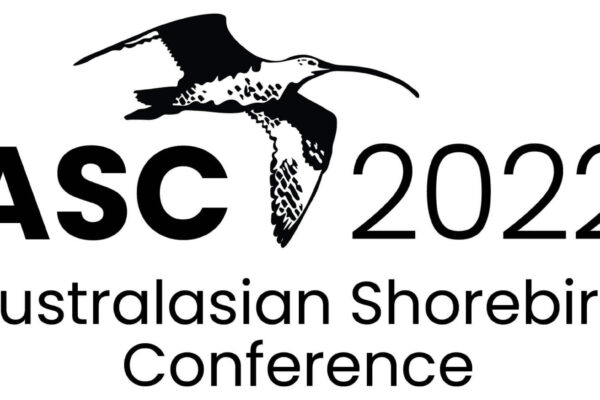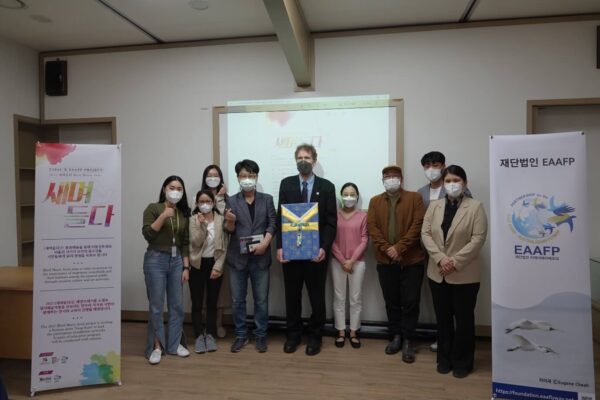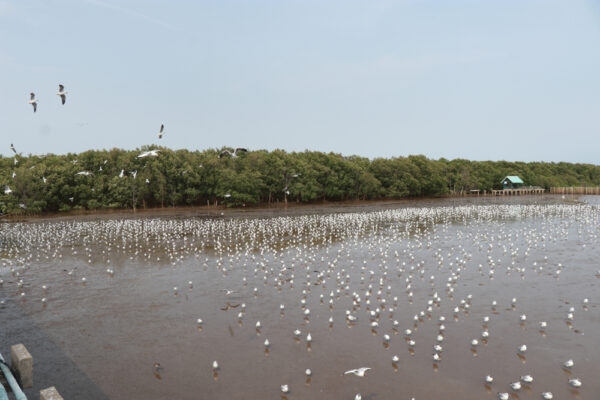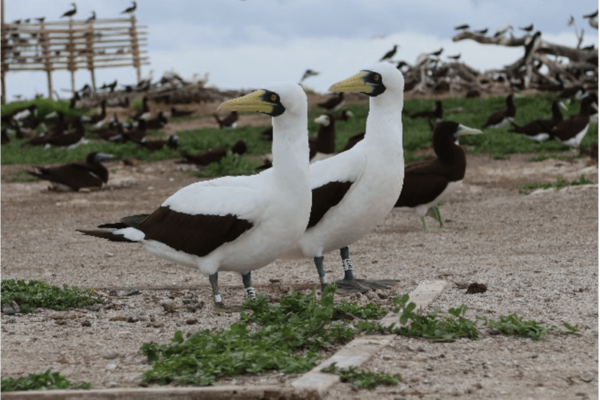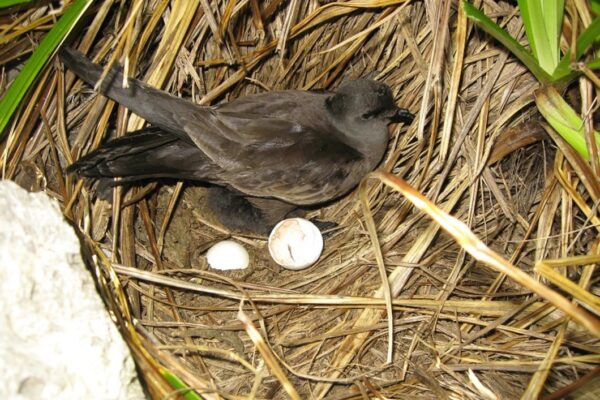-
Youth Think Tank Competition for EAA Flyway – 2nd Training workshop
On 28th - 29th May, the Youth Think Tank Competition in the East Asian-Australasian Flyway (EAAF) engaged youth participants with a webinar and in-depth training workshop on Engaging Local Communities in Conservation of Migratory Waterbirds and Wetlands. One in a series of workshops that aims to build capacity for young conservationists on wetland and migratory waterbirds conservation in the flyway across various disciplines, the 2-day virtual workshop was organized by the EAAF Partnership Secretariat with the help of the youth organizing team. More than 100 youth actively participated in the discussions and workshops. Day 1 The workshop opened on 28th May 2022 with a webinar, “Understanding Nature-based Solutions and Local Community Engagement in Conservation of Migratory Waterbirds and Wetlands.” The 1-hour webinar focused on presentations from speakers, Ms. Kathryn Bimson, Programme Officer for IUCN Regional Asia Office, and Mr. Jiefeng Jin, Conservation Officer for the International Crane Foundation. The first presentation, given by Ms. Kathryn Bimson, was an introductory presentation on Nature-based solutions and was followed by an introductory presentation on Engaging local community in conservation by Mr. Jiefeng Jin. Both presentations helped participants ease their way into the topic and the in-depth training workshop, “Engaging Local Communities in Conservation of Migratory Waterbirds and Wetlands” that came afterwards. [PPT Materials] Introduction to Nature-based Solutions (link) / Introduction to Engaging Local Community in Conservation (link) The in-depth workshop was led by Ms. Mercy Kariuki, Programme Officer (Local Engagement and Empowerment Programme) from BirdLife International and focused on “Engaging Local Communities in Conservation of Migratory Waterbirds and Wetlands”. She emphasized the significance of Free, Prior and Informed Consent (FPIC) in the process of conservation and how the work is increasingly adopting a human rights-based approach. To delve further into the topic, the presentation was followed by a case study by Mr. George Ndung’u Muigai, Founder of the Cranes Conservation Volunteers, on the conservation of Cranes in Kenya. During his presentation, Mr. Muigai shared on-the-ground experiences engaging with the community and exchanged practical advice with the youth participants. [PPT Materials] Engaging Local Communities in Conservation of Migratory Waterbirds and Wetlands (link) / Conservation of Cranes in Kenya (link) The breakout session, participants discussed the positive and negative relations between conservation and people, so that they could learn to think in different perspectives – from local communities to conservation. The participants shared actual experiences from their respective regions and project implementations. Day 2 The in-depth workshop continued on 29th May with a short summary presentation from Ms. Mercy Kariuki before delving into a case study from Amy M. Lecciones, Executive Director of the Society for the Conservation of Philippine Wetlands, Inc who tackled Empowering Communities for Managing Agricultural Wetlands. In her presentation, Amy shared the case in Paligui Wetlands (a part of the greater key biodiversity area of Candaba Wetlands) of how local farmers were trained to be local eco-tour guides. Amy enumerated some key activities for community engagement and social challenges with the proposed conservation measures taken in Paligui. (PPT Materials) Following next was a case on Hong Kong Fishpond Conservation Scheme presented by Mr. Johnson Chung of The Hong Kong Bird Watching Society. Mr. Johnson shared how local fishermen helped to enhance the biodiversity of fishponds within the Ramsar Site and being an important player in the conservation project. Johnson shared different ways to motivate the local communities as well as the general public to support the management agreements. The outputs were beyond conserving migratory birds but also benefitted local fishermen while maintaining traditions and cultures in Hong Kong. (PPT Materials) The last case study was presented by Professor Wataru Kitamura of Tokyo City University on the Little Tern project. He shared how the once-disappeared population of Little Tern was brought back to the urban areas in Tokyo Bay area. The project demonstrated the success and need for a strong scientific base, and how it can be developed into a good citizen science programme to engage the locals and general public garner their support. It was also an innovative solution to create habitats for the birds with the use of the rooftops of building in the middle of the city. (PPT Materials) After that, the participants broke out into groups to practice stakeholder analysis of the different case studies that were presented. Youth participants shared their perspectives on identifying stakeholders and ideas on engaging them with participatory conservation objectives. [Webinar] Understanding Nature-based Solution and Local Community Engagement in Conservation of Migratory Waterbirds and Wetlands [In depth Workshop] Engaging Local Communities in Conservation of Migratory Waterbirds and Wetlands: Session 1 [In depth Workshop] Engaging Local Communities in Conservation of Migratory Waterbirds and Wetlands: Session 2 Evaluation: All 20 participants had an increase in learning for the topic of nature-based solutions. In the pre-workshop survey, half of the participants responded that they had some familiarity with the topic. In the post-workshop survey, however, 90% responded they were now familiar or ‘ready to go pro’ with nature-based solutions. All participants were satisfied and found what they learned during the workshop useful in their volunteer/work. Participants rated these three components with the highest scores: 1) trainers and speakers of the workshop (4.5/5); 2) case study presentations (4.5/5); 3) contents of the workshop (4.5/5). The most valuable learnings/ takeaways for the participants were: 1) Free, Prior and Informed Consent, 2) Stakeholder mapping and analysis and 3) Nature-based Solutions. Takeaways: Participants wrote that most valuable learnings/ takeaways for the workshop was: 1) Free, Prior and Informed Consent, 2) Stakeholder mapping and analysis and 3) Nature-based Solutions. In the words of the Flyway youth: “What really stayed in my head and in my notes also is the quote "Recognizing diversity and engaging stakeholders helps in building legitimacy, developing innovative solutions, enhancing transparency, and most importantly, in upholding social equity." “It is evident that we are currently experiencing biodiversity loss. Hence, it is a must to take action. However, there are various factors that we need to consider first. For example, the effects of the conservation programs that we want to implement on the local communities and vice versa. As conservationists, we should understand the social contexts. A way for us to plan everything is to create a stakeholder analysis. It is a process for us to be able to map and identify the target people before the project begins. Acknowledgment The Youth Think Tank Competition for the EAA Flyway Organizing Team acknowledges the great contribution from the speakers and trainers: Mercy Kariuki, George Ndung’u Muigai, Amy M. Lecciones, Johnson Chung, and Wataru Kitamura, as well the youth organizing team: Frances Alvares, Jord Earving Gadingan, Oscar Yu, Thura Soe Min Htike, Yeonju Park, Yuji Lim and Yoomi Sim. The webinar was moderated by Ms. Yoon Kyung Lee, External Relations Manager of the EAAFP Secretariat. The in-depth workshops were co-moderated by Ms. Yuji Lim, Ms. Yeonju Park, Ms. Yoomi Sim from the EAAFP Secretariat and Mr. Thura Soe Min Htike from Myanmar. Ms. Vivian Fu, Communication Officer of the EAAFP Secretariat led the coordination of the workshop. To learn more about the speakers and trainers click here. For more on the Youth Think Tank Competition click here.
Continue reading -
YSFAC X EAAFP PROJECT 2022 Bird Meets Arts 2nd Education Program
On 11th June, the second public event of the education…
Continue reading -
Updates of worldwide Avian Influenza situation by FAO/EMPRES-AH (Mar 2022 – Jun 2022)
FAO/EMPRES-AH is constantly monitoring the avian influenza situation worldwide and compiles information from multiple national and international sources as well as peer-reviewed scientific articles. Close collaboration with country and…
Continue reading -
WWF-Hong Kong celebrates World Migratory Bird Day with Earth Hour Concert
In celebration of the World Migratory Bird Day on 14 May, WWF-Hong Kong hosted an online concert featuring popular Hong Kong artists to raise awareness of migratory birds and wetland conservation. This year’s focus of the World Migratory Bird Day is “Light Pollution” to address this growing threat to migratory birds. The theme is aligned with Earth Hour’s concept, each year, people across the world join hands to switch off their non-essential lights for one hour for our nature. The online concert is an extension of Hong Kong’s Earth Hour event under the theme “Habits Protect Habitats”, calling for public support to change our habits and take action now to create positive impacts on our planet. Photo Credit: © WWF-Hong Kong The concert started with an introduction to World Migratory Bird Day and highlighted the importance of wetland conservation. 12 celebrities performed 18 songs and participated in mini-games that related to conservation and sustainable living. The event has received a positive impact, more than 3,000 people joined and supported the concert. Besides, an Earth Hour MV “Dear future self in 10 years” was also released featuring Earth Hour ambassadors and kids, with beautiful nature scenes of Mai Po and soundbites advocating for nature conservation and changing our habits. Meanwhile, WWF-Hong Kong has also collaborated with East Asian – Australasian Flyway Partnership (EAAFP) and launched an updated Education Pack “Lolo’s Flying Journey” about Black-faced Spoonbill. Our education team has been using this tool virtually through engaging Zoom sessions to educate Hong Kong students, despite the COVID restrictions during the past three months. These activities have received positive feedback from students and teachers. The online learning and teaching materials developed by WWF-Hong Kong can be found here. Both Earth Hour and World Migratory Bird Day are not just about an hour or a day, it’s about committing every day to safeguard our nature and change the way we live. COVID has shown how connected our world is now but also how fragile it can be. Forests are fragmenting, rivers and streams no longer flow as they use to and wetlands are disappearing. We need to reflect on what we have done to nature and how we can fix it. There’s no time to waste and we have to act now to change our habits, even from the most simple things like “dim the lights”, together, it’s still possible to turn the tide and create a nature-positive world. Photo Credit: © William Yeung / WWF-Hong Kong Article prepared by Karen Zhang from WWF-Hong Kong.
Continue reading -
New paper sheds light on distribution and conservation challenges for Baer’s Pochard
Baer's Pochard ©Luo Jianhong An important new paper, led by Beijing Forestry University, was published in April 2022 about changes in the distribution of Baer's Pochard (Aythya baeri), a critically endangered duck in the EAAF. The paper, entitled "Shifted to the South, Shifted to the North, but No Expansion: Potential Suitable Habitat Distribution Shift and Conservation Gap of the Critically Endangered Baer’s Pochard (Aythya baeri)" reflects seven years of surveys across its historical range. The results show: The southernmost breeding site is about 1400 km south of its current IUCN breeding range; The northern-most wintering site is 800 km north of the IUCN wintering range; Six newly discovered sites in Hebei, Henan, Shandong, Jiangxi and Hubei provinces in China are confirmed to be used all year round; Most sites (81.8%) are not located in protected areas (PAs), and the majority of the suitable habitats (90%) are not protected by the current PA network. Fig. 1. Updated Distribution Map of Baer’s Pochard based on this study. The findings reveal substantial changes to the distribution of Baer’s Pochard and that there are many distribution overlaps throughout its annual migration circle (e.g., many historical stopover sites become breeding habitats). Moreover, most of the habitats overlap with urban developed areas and are outside the current PA network. The authors suggest that the existing PA network may be less effective for the conservation of this critically endangered species under predicted global climate change, and other effective area-based conservation measures should be part of the conservation strategy. More importantly, as the distribution of Baer’s Pochard covers at least 15 countries, closely coordinated cross-border cooperation will be critical for its future survival. Access the full paper here. Article prepared by Terry Townshend of Baer's Pochard Task Force.
Continue reading -
Announcement of 12th Australasian Shorebird Conference
The 12th Australasian Shorebird Conference will take place from 29-30 October 2022, hosted jointly by the Australasian Wader Studies Group and the Queensland Wader Studies Group. We are pleased to announce that the Conference will be an online event, in hopes of encouraging broad participation from around Australia and across the East Asian – Australasian Flyway. The theme for this Conference is “Global Strategies Local Actions” and through the Conference program, we will look at what has been happening across the East Asian – Australasian Flyway since the 11th Australasian Shorebird Conference held in 2018. We have developed an exciting program on shorebird natural history, counting, research and local conservation action over the last 4 years to give you a fascinating insight into the knowledge and understanding of shorebirds as well as the work being done towards their conservation. We know of the many ongoing challenges that shorebirds face, including loss of habitat, hunting, pollution and competition for food resources. Add to that the increasing threats from climate change and greater impacts from a growing human population in the Flyway, their world becomes more and more uncertain. Strong efforts are being dedicated at the global and local level to understanding, raising awareness for, and addressing the problems facing shorebirds. You will see this reflected through the range of exciting sessions during the two days. Knowledge and action go hand in hand, and we will see all the efforts that have been put in to achieving better outcomes for shorebirds. All keen “shorebirders” will find the program of interest however you are engaged with our amazing shorebirds. We encourage you to register and join the Conference to learn more about and be part of the wonderful world of shorebirds and those seeking to ensure their conservation. Conference official website, visit here. Abstract submission deadline: 15 August, 2022 Participation registration deadline: 30 October, 2022 Mark Barter Travel award information, check here.
Continue reading -
First joint public lecture of 2022
to promote migratory waterbirds and Art in Incheon On 18th May, the first public lecture of the education program of 2022 <Bird Meets Arts> proceeded successfully. Launched in 2021, the <Bird Meets Arts> has been…
Continue reading -
Thailand is preparing to propose Bangpu Nature Education Center as Flyway Network Site
Office of Natural Resources and Environmental Policy and…
Continue reading -
Masked Future
The article I wrote, ‘Are the Masked Boobies Home for Good In Tubbataha? A rollercoaster ride on the wings of hope’, was published at the East Asian-Australasian Flyway Partnership website in 2020. It was filled with hope and a smattering of apprehension and despair. Then, I was confident that we would see the resurgence of the masked booby Sula dactylatra population in the Tubbataha Reefs Natural Park Flyway Network Site (EAAF 123) in the Philippines. This singular pair of masked boobies known in the Philippines, has been with us since 2019. The second batch of eggs that it laid resulted in one chick that grew to five months, but which the rangers later found dead for unknown reasons. Marine park rangers regularly monitor the seabirds of Tubbataha, with special attention given to this finicky pair. Rangers built a complicated drainage network to rival that of ancient Rome to ensure the nests remain dry during the rainy season. They would practically walk on tiptoes around these celebrities for fear of causing undue stress. Five times more the pair laid eggs, usually a couple, and these would disappear without a trace, a mystery we have since brought to the attention of seabird experts worldwide through various seabird expert groups. Luckily for us, many were willing to help. Dr. Enriqueta Velarde of the Pacific Seabird group introduced us to Dr. Roxana Torres of the Universidad Nacional Autónoma de México, who specializes in boobies. Like us, Dr. Torres was disconcerted by the breeding failure of our Masked Boobies. At her behest, we tagged the two Masked Booby with metal and plastic ring bands during our seabird census in May 2022 for identification. We are poised to install a camera trap to monitor their breeding behavior and to identify the ‘thief’ of their precious eggs. And so, it is time to wait, to be patient, and to observe in silence. Figure 1. Park ranger, Segundo Conales, and reseracher, Ace Acebuque, installed rings on our lone Masked Booby pair. © B.Jimenez/TMO This couple laid seven pairs of eggs in two years, laying eggs almost every other month during the first quarter of this year alone. It earnestly wants to survive and is working double-time to perpetuate the species. As it is, we can but wait and do what little we can to unmask the future that lies ahead. Meanwhile, the Masked Booby colony we dream of will have to wait. Figure 2. Masked Booby 446 and 256 now sport colored and metal wedding rings. © R.Alarcon/TMO If you have any advice for us, we would be so happy to hear from you! Email Tubbataha at tmo@tubbatahareefs.org or message via Facebook page: @OfficialTubbataha Learn more about this site: https://www.eaaflyway.net/philippines/ Prepared by Angelique Songco, Superintendent, Tubbataha Reefs Natural Park Flyway Network Site
Continue reading -
Asian Waterbird Conservation Fund (AWCF): Securing the future of our highflyers!
Along the East Asian-Australasian Flyway, 36 and 19 species are globally threatened and near threatened respectively. On today’s Endangered Species Day, WWF-Hong Kong is pleased to announce that the Asian Flyways Initiative Grant (AFI Grant) will support researches on the critically endangered Baer’s Pochard (Aythya baeri; Figure 1) and near threatened Swinhoe’s Storm-petrel (Hydrobates monorhis; Figure 2) while the implementation of the seabird conservation action plan by Isla Biodiversity Conservation in the Philippines will be supported by Dr. Lew Young Grant. Both grants are under Asian Waterbird Conservation Fund (AWCF). In the Baer’s Pochard project, researchers at the Qufu Normal University will identify the nesting locations of the pochard in Nanyang Lake in Shandong Province and estimate the breeding success by monitoring the number of chicks and their survival rate. Threats faced by this species during the breeding period such as by-catch in fish harvesting activities will also be investigated. Mr. Simba Chan, one of the Committee Members of AWCF commented “In my opinion, this is the most important application not only in this year but also in recent years. Shandong is important to Baer’s Pochard but the breeding sites there are not very well-known.” For the Swinhoe’s Storm-petrel project, besides studying reproductive success, the Australasian Seabird Group will track 20 individuals from Chilbaldo, Ro Korea (also Flyway Network Site EAAF 107) with the use of geolocators to reveal the foraging locations during both breeding and non-breeding seasons. Dietary study will also be carried out. “Increased research on seabirds is urgently needed in the Yellow Sea. The work will build a better understanding of the potential impacts of expanding wind farms on seabirds.” said Mr. Doug Watkins, another Committee Members of AWCF and the Chief Executive of East Asian-Australasian Flyway Partnership Secretariat. With the support from the Dr. Lew Young Grant 2021, Isla Biodiversity Conservation successfully organized the 1st National Seabird Forum and Action Planning Workshop in the Philippines in October 2021 with the participation of over 100 stakeholders from government, NGOs, academe and birdwatching groups and bird tour companies. A national action plan for the conservation of seabirds (2022-2026) was finalized and the coming project aims to collaborate, capacitate, and work with local stakeholders and national agencies in developing a national CEPA action plan and in piloting a training programme for seabird monitoring and research. “AWCF aims to provide much-needed funding to fill the critical knowledge gap and catalyze pivotal action to conserve some of the most threatened migratory waterbird species in the region. Through the deep and extensive research and collaboration in these projects, we are hopeful that the bird populations can fly up high again in the near future.” Ms. Nicole Wong, CEO, WWF Hong Kong added. Figure 1. A family of Baer’s Pochard in Nanyang Lake, Shandong Province ©Xuefang Li Figure 2. A Swinhoe’s Storm-petrel’s nest ©Shinan County Article prepared by Fion Cheung from AWCF Secretariat
Continue reading

